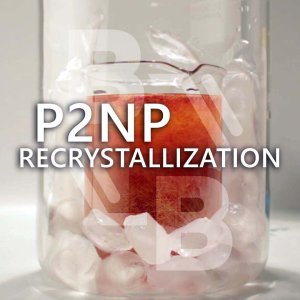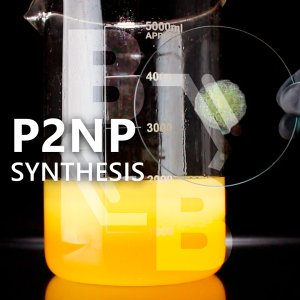You should upgrade or use an alternative browser.
Phenyl-2-Nitropropene: Synthesis, Properties, and Applications
Phenyl-2-Nitropropene: Synthesis, Properties, and Applications
Introduction to 1-Phenyl-2-Nitropropene (P2NP)
1-Phenyl-2-Nitropropene (P2NP) is a chemical compound with the molecular formula C9H9NO2. It is commonly known as P2NP and is widely used in the field of chemistry for various purposes, including pharmaceuticals and illicit drug synthesis. Phenyl-2-nitropropene is employed in the pharmaceutical industry to produce Adderall, an Amphetamine blend used to address ADHD and narcolepsy. P2NP is a yellow crystalline powder that is soluble in organic solvents and has a distinct odor. Due to its versatile properties, P2NP has gained popularity among chemists and researchers for its diverse applications.
Phenyl-2-Nitropropene Physical properties
-
CAS Number: 705-60-2;
-
Chemical formula: C9H9NO2;
-
Molar mass: 163.173 g/mol;
-
Density: 1.141±0.06 g/cm3;
-
Melting Point: 64 – 66 °C (147 to 151 °F; 337 to 339 K);
-
Boiling point: 263.0 ± 9.0 °C (352.6 °F; 451.2 K);
-
Appearance: light-yellow crystalline solid;
Phenyl-2-Nitropropene Chemical properties
-
Solubility in water: practically insoluble in water;
-
Soluble:
-
DMF 30 mg/ml
-
DMSO 30 mg/ml
-
Ethanol 10 mg/ml
-
Acetone
-
Chloroform
-
Dichloromethane
-
Methanol
IUPAC name: (2-Nitroprop-1-en-1-yl)benzene
Other names: P2NP; 1-Phenyl-2-nitropropene; β-methyl-β-nitropropene; trans-beta-Methyl-beta-Nitrostyrene; (2-Nitro-1-propenyl)benzene
Step-by-Step Synthesis of Phenyl-2-Nitropropene: Popular Methods and Tips
The Henry reaction can be used to make phenyl-2-nitropropene out of benzaldehyde and Nitroethane. It can be purified by recrystallization using hexane, methanol, ethanol, or isopropanol.
It is important to note that the synthesis of phenyl-2-nitropropene involves handling hazardous chemicals and should only be performed by trained professionals in a controlled environment. Additionally, proper safety precautions, including the use of personal protective equipment (PPE) and adequate ventilation, should be followed to minimize the risk of exposure to toxic chemicals.
Common Uses of Phenyl-2-Nitropropene: From Pharmaceuticals to Drug Synthesis
P2NP has application in the pharmaceutical industry, phenyl-2-Nitropropene is used as an intermediate in the synthesis some medications like Adderall. It serves as a key building block in the production of this drug, contributing to their chemical structure and overall pharmacological properties.
However, phenyl-2-Nitropropene has also been associated with illicit drug synthesis, particularly in the production of amphetamine and methamphetamine, an illegal stimulant. Phenyl-2-Nitropropene is commonly used as a precursor in the “Reduction” method, which involves converting phenyl-2-Nitropropene into amphetamine using a one-pot reduction reaction. It is important to note that the production of amphetamine is illegal in most countries and is associated with severe legal consequences. Phenyl-2-nitropropene also is employed as an analytical reference or starting point for creating nitro-lacquers.
Is Phenyl-2-Nitropropene Legal? Legal Status and Regulations
In many countries, phenyl-2-nitropropene is considered a controlled substance due to its potential for misuse in the illicit manufacture of drugs such as amphetamines and methamphetamines. As such, its production, distribution, and use may be subject to strict regulations and laws aimed at preventing its diversion for illegal purposes.
P2NP is legal uncontrolled substance in USA according lists [1] of Scheduling Actions, Controlled Substances and Regulated Chemicals of DEA. Also, P2NP is legal in European union according European Monitoring Centre for Drugs and Drug Addiction (EMCDDA) lists [2].

It’s crucial for individuals and businesses involved in the production, distribution, or use of P2NP to be aware of the legal status and regulations applicable in their respective jurisdictions. Failure to comply with these regulations can have serious legal consequences, including fines, penalties, and criminal charges.
It’s also important to note that regulations related to phenyl-2-nitropropene and its derivatives can change over time, and it’s essential to stay updated with the latest regulations and guidelines issued by relevant regulatory authorities. Consulting with legal professionals or regulatory experts can provide further guidance on compliance with applicable laws and regulations related to P2NP.
Safety Precautions for Handling Phenyl-2-Nitropropene: Hazards and Best Practices
As with any chemical compound, Phenyl-2-Nitropropene poses potential hazards if not handled properly. It is crucial to follow appropriate safety precautions when working with Phenyl-2-Nitropropene to minimize the risks associated with its handling. Some of the key safety precautions for handling phenyl-2-nitropropene include:
- Personal Protective Equipment (PPE): Always wear appropriate PPE, including gloves, goggles, and a lab coat or protective clothing, when working with phenyl-2-nitropropene. This helps to prevent direct contact with the skin, eyes, and clothing, reducing the risk of exposure.
- Ventilation: Ensure that the work area is well-ventilated to prevent the accumulation of vapors or fumes. Work in a fume hood or in a well-ventilated area to minimize the inhalation of potentially toxic fumes.
- Storage and Disposal: Store Phenyl-2-Nitropropene in a secure, well-ventilated area away from heat, flame, and incompatible materials. Follow proper procedures for disposal of phenyl-2-nitropropene and its waste in accordance with local regulations and guidelines.
- Handling: Avoid ingestion, inhalation, or skin contact with phenyl-2-nitropropene. Handle phenyl-2-nitropropene with care and use appropriate techniques, such as pipetting, to prevent spills or splashes.
- Emergency Preparedness: Be prepared for emergencies by having a spill response plan in place and being familiar with the appropriate first aid measures in case of accidental exposure.
- Training and Knowledge: Ensure that personnel handling phenyl-2-nitropropene are properly trained and knowledgeable about the hazards associated with the compound. Stay updated with the latest safety guidelines and best practices.
Toxicity and Rules for Handling the Substance
On the skin: Can cause irritation to the skin and mucous membranes.
On the eye: Can be irritating.
LD/LC50 values that are pertinent for the classification:
-
An oral dose of 500 mg/kg or more is lethal to rats
-
An intraperitoneal dose of 200 mg/kg is LD50 to rats.
Storage
No particular precautions are required if used appropriately. Refrain from inhaling dust/fumes/gases/mists/vapours/spray. Abstain from extended or recurrent exposure. Keep away from ignition sources. Ensure safety against static electricity. Make sure the container is sealed tight.
The optimal temperature for storage is 2-8°C. When kept at a temperature higher than this, phenyl-2-nitropropene is not very enduring, and decomposes over time.
Conclusion: Know the Facts about 1-Phenyl-2-Nitropropene (P2NP)
In conclusion, 1-Phenyl-2-Nitropropene (P2NP) is a chemical compound with diverse applications in various industries, including pharmaceuticals and illicit drug synthesis. It is important to be aware of the proper synthesis methods, legal status, and safety precautions associated with phenyl-2-nitropropene to ensure responsible handling and use. Always follow local regulations, guidelines, and best practices when working with P2NP or any other chemical compound to protect human health and the environment.
Bibliography
-
[1] Green List – List of Psychotropic Substances Under International Control (International Narcotics Control Board (INCB)).
-
[2] DEA Drug Scheduling.
-
Verweij, Anthonie MA. “Impurities in illicit drug preparations: amphetamine and methamphetamine.” Forensic Sci. Rev 1.1 (1989): 1-11. https://erowid.org/archive/rhodium/chemistry/meth.impurities3.html
-
DeRuiter, Jack, C. Randall Clark, and F. Taylor Noggle. “Gas chromatographic and mass spectral analysis of amphetamine products synthesized from 1-phenyl-2-nitropropene.” Journal of chromatographic science 32.11 (1994): 511-519. https://academic.oup.com/chromsci/article-abstract/32/11/511/609027
-
Phenyl-2-nitropropene https://en.wikipedia.org/wiki/Phenyl-2-nitropropene
-

P2NP 1-Phenyl-2-Nitropropene CAS 705-60-2
P2NP 1-Phenyl-2-Nitropropene CAS 705-60-2 【Payment】: Accept Cryptocurrency(bitcoin, usdt, xmr. etc), Western union, Money Gram, Alipay, TT ESCROW! 【Price】$300/kg(for reference only) Product Name: 1-Phenyl-2-nitropropene Synonyms...- jellycatti
- Resource
- 1-phenyl-2-nitropropene cas 705-60-2 p2np
- Category: Nitro compounds
-

P2NP 1-Phenyl-2-Nitropropene CAS 705-60-2
Product Name: 1-Phenyl-2-nitropropene Synonyms: 1-(PHENYL)2-NITROPROPENE;2-NITROPROP-1-ENYLBENZENE;2-NITRO-1-PHENYLPROPENE;BETA-METHYLNITROSTYRENE;TRANS-BETA-METHYL-BETA-NITROSTYRENE CAS NO: 705-60-2 EINECS: 627-363-3 Molecular Formula: C9H9NO2 Molecular Weight: 163.17 Boiling Point...- Toptech Coco
- Resource
- 1-phenyl-2-nitropropene cas 705-60-2 p2np
- Category: Nitro compounds
-

Phenyl-2-nitropropene P2NP
Purity: 98% CAS: 705-60-2 Formula: C9H9NO2 250g- 100 euro 500g- 200 euro 1kg- 300 euro Our company carries out the delivery of any goods that are not prohibited by law from China to the EU. You can receive your goods in a specially equipped cache or by courier delivery.- Cargo Chemicals
- Resource
- 1-phenyl-2-nitropropene p2np p2p phenyl-2-nitropropene
- Category: Aldehydes and Ketones
-
A
P2P via Benzaldehyde and MEK
Has anyone had success with this method using benzaldehyde MEK and sodium perborate?- american gopnik
- Thread
- 1-phenyl-2-nitropropene
- Replies: 9
- Forum: Amphetamines (Phenylethylamines)
-

P2NP Recrystallization
1-Phenyl-2-nitropropene (P2NP) recrystallization via IPA (isopropyl alcohol). https://bbgate.com/threads/1-phenyl-2-nitropropene-p2np-video-synthesis-from-benzaldehyde-and-nitroethane-henry-reaction.52/- Novator
- Media item
- 1-phenyl-2-nitropropene 1-phenyl-2-nitropropene recrystallization 1-phenyl-2-nitropropene video amphetamine breaking bad p2np p2np recrystallization p2np synthesis recrystallization stimulant
- Comments: 9
- Category: Synthesis of Amphetamines (Phenylethylamines)
-

1-Phenyl-2-nitropropene synthesis
Benzaldehyde and nitroethane Henry condensation. https://bbgate.com/threads/1-phenyl-2-nitropropene-p2np-video-synthesis-from-benzaldehyde-and-nitroethane-henry-reaction.52/- Novator
- Media item
- 1-phenyl-2-nitropropene amphetamine benzaldehyde cas 100-52-7 cas 705-60-2 henry reaction nitroethane p2np p2np synthesis phenyl-2-nitropropene video synthesis
- Comments: 42
- Category: Synthesis of Amphetamines (Phenylethylamines)
-

Amphetamine synthesis from P2NP via Al/Hg (video)
- HIGGS BOSSON
- Thread
- 1-phenyl-2-nitropropene adderall amphetamine amphetamine synthesis amphetamine video amphetamines amphetamines salts cas 300-62-9 cas 705-60-2 p2np
- Replies: 803
- Forum: Amphetamines (Phenylethylamines)
-

P2P Synthesis From P2NP
Reagents: 1-Phenyl-2-nitropropene (P2NP; cas 705-60-2) 1000 g; Methanol (MeOH) 10 L; Sodium borohydride (NaBH4) 470 g; Hydrogen peroxide (H2O2) 30% 6 L; Potassium carbonate (K2CO3) 1800 g; Hydrochloric acid (HCl) 37% aq; Dichloromethane (CH2CI2) 5 L; Sodium hydroxide (NaOH) 5 L 25% aq...- GhostChemist
- Thread
- 1-phenyl-2-nitropropene 1-phenyl-2-propanone bmk cas 103-79-7 cas 705-60-2 p2np p2p p2p synthesis p2p synthesis from p2np phenylacetone synthesis
- Replies: 59
- Forum: Amphetamines (Phenylethylamines)
-

One-pot Amphetamine Synthesis From P2NP With NaBH4/CuCl2 (1kg scale)
Reaction scheme: Equipment and glassware: 50 L batch reactor with a reflux condenser, top stirrer and heating apparatus in a set-up; Drip funnel; Conventional funnel; Laboratory grade thermometer (up to 150 °С); Several buckets for 10 and 20 L; Measuring cylinder for 1 L; Vacuum source...- GhostChemist
- Thread
- 1-phenyl-2-nitropropene adderall amphetamine amphetamine synthesis amphetamines amphetamines salts cas 300-62-9 cas 705-60-2 one-pot amphetamine synthesis p2np
- Replies: 900
- Forum: Amphetamines (Phenylethylamines)
-

1-Phenyl-2-nitropropene (P2NP) Video Synthesis From Benzaldehyde and Nitroethane. Henry Reaction.
Reaction scheme: Equipment and glassware: 10 L Flask; Retort stand and clamp for securing apparatus (optional); Reflux condenser; Funnel; Vacuum source; Laboratory scale (0.1-500 g is suitable) - optional; Measuring cylinders 1000 mL and 100 mL; Water bath; Glass rod and spatula; Filter...- GhostChemist
- Thread
- 1-phenyl-2-nitropropene benzaldehyde cas 100-52-7 cas 705-60-2 cas 79-24-3 henry reaction nitroethane p2np p2np synthesis phenyl-2-nitropropene video synthesis
- Replies: 266
- Forum: Amphetamines (Phenylethylamines)
-

Phenylacetone (P2P) synthesis from 1-phenyl-2-nitropropene (P2NP) via FeCl3
Reagents: 1-Phenyl-2-nitropropene (P2NP; cas 705-60-2) 1.63 g, 10 mmol; Powdered iron (Fe) 3 g; FeCl3 0.6 g; Hydrochloric acid (HCl 36% aq.) conc. 4 ml; Toluene 15 ml; Water 55 ml; Hydrochloric acid 3N (10.45%) HCl 25 ml; Sodium bicarbonate (NaHCO3); Magnesium sulfate (MgSO4); Equipment and...- WillD
- Thread
- 1-phenyl-2-nitropropene bmk cas 103-79-7 cas 705-60-2 p2np p2p synthesis phenyl-2-propanone phenylacetone synthesis synthesis manual
- Replies: 25
- Forum: Amphetamines (Phenylethylamines)
About Us
Our team brings together the best specialists from different fields.
We are ready to share our experience, discuss difficult issues and find new solutions.
Mirror Links
Help Pages
Follow us
Popular Tags
-
Free product samples
Testing products from new vendors and manufacturers.
Get free samples for testing now!
-
Always stay in touch with BB forum. Element/Matrix.
Connect notifications to always stay in touch with the forum!
Connect
